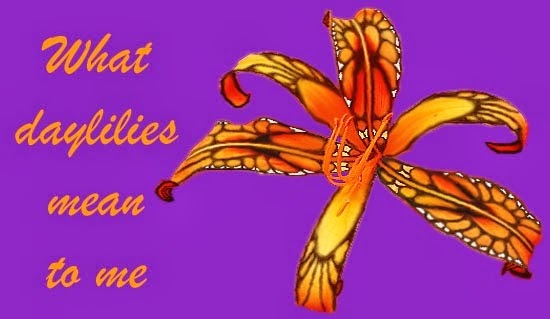There aren't many early spring blooming bulbs for zone 6 that exhibit the scrumptious hot pink through raspberry and cerise that are my favorite daylily colors. There's the deep fuchsia 'Jan Bos' hyacinth and Cyclamen coum and there's...well, that's all I can think of. But come May in these parts, there's a ton of tulip cultivars in those shades available. I don't grow any of them. For me, tulips should be red.
Now, if you were to ask me my favorite color, I'd say orange. Orange peel orange. A little bit neonish, like Highland Pinched Fingers or Tangerine Parfait. But I never did acquire Primal Scream because orange is not my favorite color for daylilies.
A year after I planted my first daylily seeds, I joined AHS and attended the region 4 meeting near Boston and came home with Vera Biaglow as my bus plant. A 1986 Moldovan that won an HM in 1989 and an AM in 1993, it is registered as being rose pink edged in silver with a lemon green throat. My eyes could not get enough of this color the first time it bloomed here, and I wanted more in my garden.
 |
| Vera Biaglow mskhay-2 |
I was made even more ecstatic by glorious color when, three years later, this Mariska X Haystack Calhoon seedling bloomed. In one fell swoop, I had captured Vera Biaglow's color and added an undertone of orange that made it even more pleasing to my eye. This was easy: take a pale pink and cross it with an orange. But just a few months after I saw my first modern daylily online, I had seen an image of Cleopatra, the daylily that made me fall for spiders. I had a slew of pale pink Dallas Star seedlings grown from a packet distributed by my club, but no orange self true spider.
 |
| Banshee Lullaby (2008) Flamingo Flambeau (2008) |
These 2 daylilies first bloomed the year following that Mariska X Haystack Calhoon lovely. In them, I saw hints of Vera Biaglow color. I still had those pale pink seedlings, and Orange You Special (2007) was blooming for its second season, but its not the glowing orange of Haystack Calhoon.
I searched and discovered what I felt was the epitome of orange self spiders, the Reinke's English Vermillon. It was sold out. So I bought its orange parent, 'Jim Cooper' with plans to cross it with Garden Portrait, thereby perhaps making my own version of English Vermillon. Meanwhile, Terri Jones had sent me Raspberry Star. Beneath it's rosy purple, I saw hints of orange, so I crossed it with pink Chin Whiskers and Flamingo Lingo was born.
 |
| Raspberry Star (Hansen 1994) Flamingo Lingo (2009) |
While most of the seedlings of Garden Portrait X Jim Cooper were glowing orange selfs close to spiderhood, every last one had bad leaves. But the seedlings of the "Garden Portrait -not" that I grow X Jim Cooper had great leaves, stupendous bud counts and fabulous color. Unfortunately, they were fat fat fat. I put pollen from Flamingo Flambeau on the best of them and my husband named the resulting intro. He'd also named Scrambled Legs.
 |
| Jim Cooper (Lambert 1968) Cerise's Pieces (2010) |
I started to see glimmerings of Vera Biaglow color in my tet crosses.
 |
| Solenoid Robot (2010) Maquis Condor (2011) |
I selected the Maquis Condor X Linguini seedling in 2012:
 |
| Mr Bill's Twister Thrills (2013) maqlin-8 |
Meanwhile, by crossing a pale lavender pink Dallas Star seedling with Screaming Eels, whose mother just happened to have been Raspberry Star, I got dozens of remarkably well budded kids approaching Vera Biaglow hood in skinny or UF form:
 |
| Fiawol (2012) Kitten Wings (2012) |
And in crossing Screaming Eels with Flamingo Flambeau, I got the start of an edged program along with deep rose red color.
 |
| Half Magic (2013) sefla-1 |
Half Magic's sibling is still being evaluated for garden-worthiness but doesn't represent progress towards Vera Biaglowhood; that has been better with tets:
 |
| Anything For Love (2013) Venusian Veyron (2013) |
Despite not being even UF, Anything For Love was allowed to live in the selected beds because I have so much more room in Burt than I did in Niagara Falls when that poor Mariska X Haystack Calhoon seedling bloomed. It is one of the few seedlings I wish I could get back.
It's no secret that I view UFs as failed spiders (and, by extension, full forms as failed UFs and therefore double failures). I simply can not be helped. When I saw Cleopatra for the first time online in 1997, I was hooked and I've gotten far worse over the years. I now view Cleopatra as too fat.
 |
| Cleopatra (Taylor 1964) Judy's Jungle Cat (2014) |
Capturing the glowing hot rose color of Judy's Jungle Cat with my camera has been difficult but it definitely ensnares garden visitors. Planned for a 2015 introduction, it has a spider ratio that ranges from 4.086 to 4.33:1 and is my closest yet to a Vera Biaglow in spider form. Still too fat for me, though. I'm pretty sure that once I get a seedling precisely the color of Vera Biaglow, it will be so skinny that you'll only be able to make out the color from certain angles. At least, that's my goal. I never had realistic goals when I dieted, either.


















